|
|
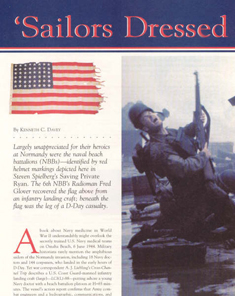 |
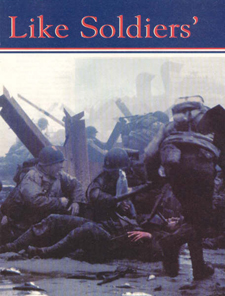 |
| |
Largely unappreciated for their heroics at Normandy were the naval beach battalions (NBBs)-identified by red
helmet markings depicted here in Steven Spielberg's "Saving Private Ryan." The 6th NBB's Radioman Fred
Glover recovered the flag above from an infantry landing craft; beneath the flag was the leg of a D-Day
casualty.
|
'Sailors Dressed Like Soldiers'
Reprinted from Naval History with permission; Copyright © 1999
U.S. Naval Institute/www.navalinstitute.org
By Kenneth C. Davey
A book about Navy medicine in World War II understandably might overlook the secretly trained U.S. Navy medical teams
on Omaha Beach, 6 June 1944. Military historians rarely mention the amphibious sailors of the Normandy invasion,
including 18 Navy doctors and 144 corpsmen, who landed in the early hours of D-Day. Yet war correspondent A. J.
Liebling's Cross-Channel Trip describes a U.S. Coast Guard-manned infantry landing craft (large)—LCI(L)-88—putting
ashore a young Navy doctor with a beach battalion platoon at H+65 minutes. The vessel's action report confirms that
Army combat engineers and a hydrographic, communications, and medical section of the Naval Sixth Beach Battalion
made a landing on "Easy Red," Omaha Beach, at 0735. A follow-up Army-Navy amphibious team in the LCI(L)-85
sustained heavy casualties when the landing craft was hit 25 times and was later sunk. Dr. John F. Kincaid,
a naval beach battalion (NBB) passenger in that craft, had the added task of rendering medical assistance
for the many wounded servicemen and dying fellow officers before going ashore on Easy Red. [D-Day art by
Dwight Shepler, USNR]
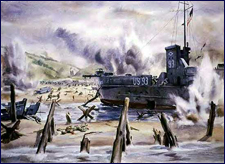 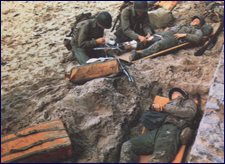
Amphibious sailors disembarking from an LCI(L) appear in a Coast Guard film, carrying explosives, M-1 carbines,
Springfields, 1917 Enfield rifles, Thompson submachine guns, communication equipment, and medical supplies. Liebling
described the beach battalion medical section as "sailors dressed like soldiers, except that they wore black jerseys
under their field jackets" and the standard Red Cross armband. These naval elements of the Engineer Special Brigades
(ESBs) have been identified in D-Day photos wearing paratrooper boots and helmets with a blue/gray band around the
base, and a red rainbow painted on the front. Liebling portrayed the LCI(L)s as carrying specially packaged Army-Navy
units for early delivery on the continent doorstep.
Working together, the ESBs and the naval beach battalions formed a link between land and sea forces. The NBBs operated
aid stations on the beach and directed the Normandy landings and the shore-to-ship phase of the seaward evacuation of
casualties. Operation Overlord's evacuation problem was to shield the demoralizing sight of heavy casualties from the
battle troops scheduled to go ashore later in the morning on D-Day. The U.S. naval beach battalions and their
British counterparts, elements of the Royal Marine Commandos, were distributed among many LCI(L)s to ensure that a
direct hit would not wipe out an entire unit. Amphibious warfare instructions for medical personnel warned that
"It is essential on landing to seek immediate cover. Only two people are seen on a modern battlefield—one who is a
casualty and one who is just about to become a casualty."
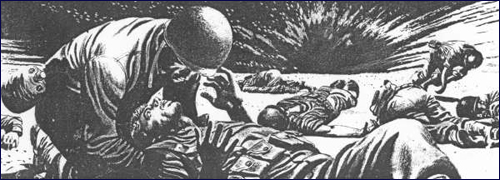
The 45 NBB sailors who made the D-Day landing at H+65 that morning went ashore to an apparent military disaster.
[Easy Red art by Fred Ludekens] Among a number of unfortunate events, most of the H-hour assault tanks scheduled to
lead the charge onto Omaha were at the bottom of the English Channel or burning on the beach. The resulting casualty
rate of the H+1 minute invasion troops and the Army-Navy gap assault teams was appalling. The Overlord nightmare of
wounded U.S. servicemen piling up on the beach already had become a reality. While beach battalion personnel joined
the assault, the medical teams, including injured doctors and corpsmen, set up aid stations and immediately began
performing their humanitarian duties. So many soldiers and sailors were wounded in the tidal flat that it was
difficult for the corpsmen to distinguish the living from the dead.
Medical conditions were catastrophic, as the rising tide was drowning dying men and washing bodies ashore in the pink,
murky water. The amphibious sailors, forced to drag casualties from the surf toward the enemy's murderous guns,
became casualties themselves. Out in the channel, pilotless landing craft filled with dead GIs were circling
aimlessly while 1,300 yards down the beach, the LCI(L)-91 and LCI(L)-92 were on fire. The unanticipated degree of
carnage and destruction of equipment necessitated the scavenging of medical supplies from the dead. To avoid further
chaos, the Navy Beachmaster, a beach battalion commander, radioed a temporary halt to the landings at 0830. While
sailors assumed combat roles in support of the infantry, officers and men of the battalions worked with the gap
assault teams in clearing beach obstacles and mines. Navy doctors and corpsmen, working beside their Army
counterparts, remained extremely busy while the surgical teams on the hospital tank landing ships (LSTs) prepared to
receive heavy casualties. Not until 1130 on D-Day did battle conditions improve so that the beach battalions were
able to begin evacuating the wounded and dying. [NBB aid station art by Mitchell Jamieson]
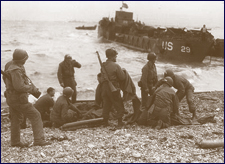 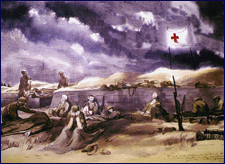
Sadly, when darkness fell over the invasion beaches, assault craft no longer would pick up casualties in the dangerous
surf. Near the Easy Red evacuation site, suffering men were heard crying on the beach, as morphine supplies were
exhausted. A warming fire for those in shock would mean instant death from German snipers. Having witnessed the
gruesome death of his partner, 18-year-old Navy Corpsman R. W. Borden begged frantically for blankets as more
Army troops came ashore. Not all could be saved, however, and the mortally wounded began pleading with the medical
officers to end their misery. Around midnight, dying Americans were lifted into rubber rafts, and the amphibious
sailors, without oars, made a desperate attempt to "dog-paddle" them through the mined surf out to the LSTs.
Although the mercy mission was unsuccessful, and a number of men spent their final hours on the far shore,
the U.S. Army cited the NBBs for saving countless lives, evacuating more than 600 casualties on D-Day alone,
and contributing materially to the capture of Omaha Beach.
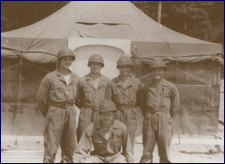
|
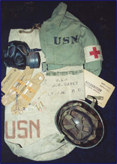
|
| |
| Standing left to right, Dr. John F. Kincaid, Dr. Mike Etzel, Beachmaster Vincent Perrin,
Dr. Russ Davey and in front, Dr. Frank Ramsey. In the beach bags of typical naval beach battalion medical teams at
Normandy were: 25 syrettes, 30 triangular bandages, a half-roll of cellulose bandage, 12 cotton swabs, 30 large
battle dressings, 20 small battle dressings, 2 rolls of adhesive tape, 1 package of basswood splints, 3 tag books, 2
plasma units, and 10 packages of pulverized sulfa.
|
For some physicians, Navy medicine in World War II was the extent of their medical careers. Doctor Kincaid, the beach
battalion doctor on the LCI(L)-85, survived bloody Omaha but was killed in action less than a year later. In a letter
dated 26 May 1945, his mother states that John died at his battle station on a destroyer off Okinawa. She wrote that
"No doubt John did more good during his short life than many of us in double the years. We just can't realize he
won't be coming back with the other boys." Lieutenant Kincaid's obituary details his D-Day experience and states
that he was 28 years old when the end came. The promising young doctor was buried at sea.
Why the U.S. Navy practically has ignored the contributions of the beach battalions in France remains unclear. Some
have suggested a continuation of Navy secrecy regarding amphibious warfare during World War II. Others speculate that
the NBBs were associated too closely with the 5th and 6th Engineer Special Brigades. From H+65 minutes to D+20 days,
the ESB surgical battalions and the 6th and 7th NBBs treated and evacuated more than 8,645 casualties from Omaha
Beach. The U.S. Army acknowledged the "extraordinary gallantry" of the NBBs and, in a proposed Unit Citation,
emphasized that the medical sections "performed their duties in an especially heroic manner." The Provisional
Government of France honored the amphibious sailors with that country's highest award, the Croix de Guerre with
Palm. Why the Unit Citation remains "proposed," and few men, or their widows, ever received medals or
accompanying papers remains puzzling.
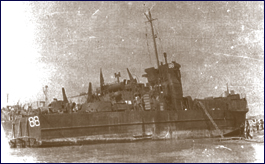 |
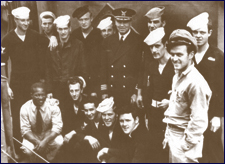 |
|
After the Normandy invasion, the LCI (L) 88 was beached in England for repairs. Note the
hole at the forward water line and missing starboard ramp. The chalk line shows where she was hit previously and
patched in Sicily. Standing in the foreground, Chief Ralph Gault, USCG, wearing the khaki working uniform, poses
with part of his LCI(L) 88 deck hands and former World Boxing Champion, Commander Jack Dempsey.
|
Over the past half-century, many books have been written about the Allied invasion of Normandy. The Naval Historical
Center contains no "official reports" of Naval Beach Battalion participation in the invasion. Archival files verify
that during the war, these specialized Navy units underwent intensive amphibious training at Little Creek, Virginia.
Recently uncovered papers of the Navy doctor on Easy Red at 0735 express great admiration for the U.S. Coast Guard
crew of the LCI(L)-88 and the heavily armed U.S. Navy amphibians who led him ashore on D-Day. The young medical
officer pays special tribute to the many casualties of D-Day and writes of "their courage and patience
immediately after receiving their wounds." More than a half-century later, NBB veterans remember the horror
of Omaha and remain haunted by the indescribable suffering of 6 June 1944. A survivor of the LCI(L)-85 who
served in Dr. Kincaid's amphibious platoon, Seaman First Class Robert Giguere, described the heroes of D-Day
as "those we couldn't save, the men we had to leave on the beach." On 8 June 1944, the medical officers
dispensed great quantities of brandy, allowing the graves registration crews to begin their solemn duties.
Military author Jonathan Gawne accurately described Dr. Kincaid and the U.S. Navy amphibians of D-Day as
"The Forgotten Sailors of the Invasion Beaches."
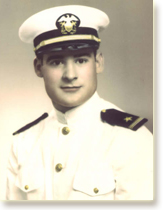 |
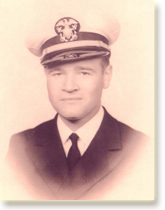 |
|
New Yorker war correspondent A.J. Liebling described 23-year-old Joe
Vaghi (left), a star college football player, running down the LCI(L)-88 port ramp, "running as if he was
running out on a field with a football under his arm." Not far behind were Battalion Commander Gene Carusi,
Coxswain Ed Marriott, John Hanley, Frank Hurley, Lewis "little boats" Strickland, Amin Isbir, Harold
Roderick, Ray Casper, John Shrode, Corpsman Andy Chmiel and 26-year-old "little Dr. Davey" (right). In
Liebling's "Cross-Channel Trip," it was 7:35 A.M. on 6 June 1944 when Beachmaster Joe Vaghi led the
'Sailors Dressed Like Soldiers' ashore "Easy Red" Omaha Beach.
|
Mr. Davey wrote this account as a tribute to his father, Dr. J. Russell Davey, Jr., and all members of the 6th Naval
Beach Battalion. Lt. Davey, USNR died 5 June 1948.
 Back to Top Back to Top
|


















